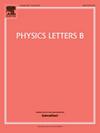违反氢衰变的重子数
IF 4.5
2区 物理与天体物理
Q1 ASTRONOMY & ASTROPHYSICS
引用次数: 0
摘要
文献中关于重子数违反(BNV)过程的研究大多集中在原子核中的自由核子或束缚核子,而对束缚原子的衰变关注有限。考虑到氢是宇宙中最丰富的原子,研究氢原子的衰变作为探测BNV相互作用的手段是特别有趣的。在这项研究中,我们首次采用鲁棒有效场理论(EFT)方法,利用常规核子衰变过程中EFT截止尺度的约束,来估计氢原子到标准模型粒子的两体衰变的衰变宽度。我们将低能量有效场理论(LEFT)、手性微动理论(ChPT)和标准模型有效场理论(SMEFT)结合起来,分别用LEFT和SMEFT威尔逊系数(WCs)来表示衰减宽度。通过应用常规核子衰变WCs的界,我们对氢的BNV衰变提供了一个保守的估计。我们的研究结果表明,所有主导双体衰变的逆偏宽度的界限都超过1044年。在这些模式中,约束最小的双光子衰变H→γγ可能是天体物理学上有趣的,尽管来自我们太阳的单色光子信号很难用目前的近地望远镜探测到。本文章由计算机程序翻译,如有差异,请以英文原文为准。
Baryon number violating hydrogen decay
Most studies on baryon number violating (BNV) processes in the literature focus on free or bound nucleons in nuclei, with limited attention given to the decay of bound atoms. Given that hydrogen is the most abundant atom in the universe, it is particularly intriguing to investigate the decay of hydrogen atom as a means to probe BNV interactions. In this study, for the first time, we employ a robust effective field theory (EFT) approach to estimate the decay widths of two-body decays of hydrogen atom into standard model particles, by utilizing the constraints on the EFT cutoff scale derived from conventional nucleon decay processes. We integrate low energy effective field theory (LEFT), chiral perturbation theory (ChPT), and standard model effective field theory (SMEFT) to formulate the decay widths in terms of the LEFT and SMEFT Wilson coefficients (WCs), respectively. By applying the bounds on the WCs from conventional nucleon decays, we provide a conservative estimate on hydrogen BNV decays. Our findings indicate that the bounds on the inverse partial widths of all dominant two-body decays exceed 1044 years. Among these modes, the least constrained diphoton decay might be astrophysically interesting, although the monochromatic photon signal from our Sun is difficult to detect with current near-Earth telescopes.
求助全文
通过发布文献求助,成功后即可免费获取论文全文。
去求助
来源期刊

Physics Letters B
物理-物理:综合
CiteScore
9.10
自引率
6.80%
发文量
647
审稿时长
3 months
期刊介绍:
Physics Letters B ensures the rapid publication of important new results in particle physics, nuclear physics and cosmology. Specialized editors are responsible for contributions in experimental nuclear physics, theoretical nuclear physics, experimental high-energy physics, theoretical high-energy physics, and astrophysics.
 求助内容:
求助内容: 应助结果提醒方式:
应助结果提醒方式:


